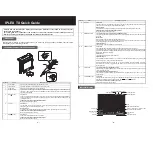
MCS260B
CORNERSTONE 260B MONOCHROMATORS
73
18.4 GRATING DISPERSION
If we fix the angle I in the grating equation and differentiate with respect to wavelength we get:
a cos D δD = m δλ
Thus:
δD
δλ
=
m
a cos D
δD/δλ is the angular dispersion or change of diffraction angle corresponding to a small change in
wavelength. It is greater for smaller groove spacing, a (greater number of lines per millimeter);
larger orders, m; and larger diffraction angles, D.
The linear d
ispersion, δL/δλ, at a monochromator’s exit slit will vary with output focal length, f, and
angle D and is the product of the focal length and angular dispersion:
δL
δλ
= f
δD
δλ
=
fm
a cos D
Normally, we use the “reciprocal linear dispersion”, which gives the wavelength dispersion in
nm/mm of slit width.
18.5 GRATING ILLUMINATION AND RESOLUTION
The resolving power R of a grating is defined in terms of wavelengths λ and λ + δλ, where λ + δλ is
the closest wavelength to λ that can be resolved. Theoretically:
𝑅 =
λ
δλ
=
W(sin I + sin D)
λ
Where:
δλ = Resolution
W = Illuminated width of the grating.
Normally the smallest slit available and optical aberrations, rather than the grating, determine the
attainable resolution.
As an example, a monochromator (in this case Oriel’s MS257 model) is set to
λ = 500 nm, with a 1200 l/mm grating, R is 60000 with a fully illuminated grating. Based on this, δλ
is 0.008 nm. With 25 µm slits the product of slit width and reciprocal linear dispersion is 0.09 nm,
which is close to the measured value of 0.1 nm and R = 5000 instead of 60000.
If however, only a few mm of the grating are illuminated, as is sometimes the case with laser
sources incorrectly coupled to the monochromator, the grating resolution can broaden the
measured bandwidths. For example, if a laser illuminates only 2 mm of the grating width, the
measured bandwidth will be 0.2 nm, even for a very narrowband laser. Very short pulse (ps) lasers
will only illuminate a small portion of the grating at any instant. The resolution is degraded in
agreement with Heisenberg’s Uncertainty Principle.
If two monochromators are used in tandem then the reciprocal linear dispersion of the combination
is half that of a single monochromator.





































